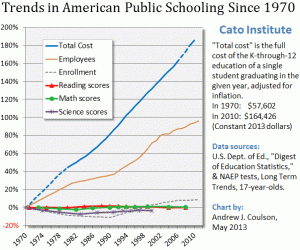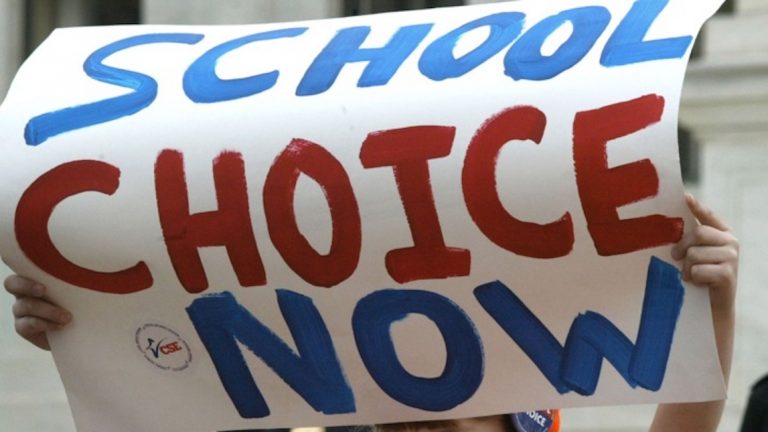“Charter school saved my life.”
This isn’t just an anecdote from a concerned constituent that I have heard in passing. These are the words this very morning of my wife, an incredibly bright, but also quite introverted woman who moved from rural Nevada to Southern California in middle school, and felt lost—struggling to thrive in enormous classes that teachers had challenges managing. Then she was given the opportunity to attend high school at a charter school in Apple Valley, CA and blossomed. She graduated at the top of her class, while taking not only college-level courses in high school, but classes at local area colleges as well.
She credits this to the idea that all students are not alike and shouldn’t be educated as such. While charter schools like hers recognize and foster individual differences in learning, public schools regress to a mean established by whatever standard du jour is imposed upon them by the federal government.
These methods may or may not make for good test scores, but even former New York state Teacher of the Year John Gatto doesn’t believe they lead to a well-educated mind that is capable of critical thinking.
I was a public high school graduate, fortunate that a few teachers cared more about whether I was thinking critically than if was writing a rough draft for my final product (let’s just say that I was notorious among the English department staff). One of those was Ms. Brewer, a history teacher who instilled in me, and thousands of students over the years—including future teachers—that history is not about what happened and when, but how things happen and why? A level of critical thinking that seems to have escaped our elected officials and bureaucrats.
The funny thing was: I chose Ms. Brewer as a teacher. I had an opportunity to pick, and decided against other instructors even though I knew that this teacher would push me and challenge me daily. She even gave me a failing grade on a junior-year term paper, and I signed up for her again the following year. In fact, there are three instances in my high school career where I was given an option to choose a teacher and did, and the results were all positive (educationally speaking, my grades didn’t always reflect my level of actual learning—much to the dismay of my parents).
Yet many people push back on the idea that by further promoting school choice, we will be doing a disservice to students, because such programs will only leave ‘scraps’ for the most needy, poor, and underprivileged.
And while some may argue that education isn’t a public good to begin with, let’s begin from an assumption that it is. Not all public goods are best offered by the government, and there are many that are not at all. Among those is one of the most debated issues of our time: health care.
The overwhelming majority of health care services today in America are provided by private entities. Whether such services also meets the classification of a public good under economic terms is as debatable as it is with education, but if we are assuming one meets that standard, then let’s say the other does as well. And yet when you compare the only widespread ‘public’ health care option, the Veterans Administration, to the private sector, you hear very few people arguing that the VA, rife with scandals and service issues, is the model to be adopted for all citizens*.
In fact, the conscious decision was made by an overwhelmingly progressive administration in 2009 to push more people into private markets by subsidizing health insurance. The very model that the ACA put forward is rather analogous to school choice proposals: assessments are paid by taxpayers who can afford a higher standard of care and translated into subsidies offered directly to those who cannot afford what the government considered an ‘acceptable’ level of care. And in this model, everyone gets to choose their provider—some with more limited options than others based on geography and availability. And even more to the point, providers get to choose patients: doctors are allowed to limit appointments for insurance providers they don’t accept, and for people with public funding like Medicaid, almost inarguably the most needy population.
If this was considered acceptable for a service where lives depend on the quality of the provider, why do we dismiss it for education? Why must we limit choice, in a system where even though everyone pays into the pot, few parents are given any accommodation for wanting a different path for their own children? And wouldn’t such choice encourage a competition amongst institutions for students which has shown at the post-secondary level that even public schools can compete with the best private institutions (in the world)?
 Instead, our federal government pours billions into failing schools thinking that money, supposedly the root of all evil, is the requisite solution. When given this money with conditions attached, only three percent of school districts chose the charter option that my wife (among many others) considered transformative. The vast majority of them simply swapped out administrators and gave the same teachers new instructional strategies—more top-down thinking that yielded disgustingly negative returns on investment. And despite Betsy DeVos’s sub-par confirmation hearing, all we heard from those most contentiously questioning her was whether she would continue this failed line of thinking and loosen the purse-strings even further.
Instead, our federal government pours billions into failing schools thinking that money, supposedly the root of all evil, is the requisite solution. When given this money with conditions attached, only three percent of school districts chose the charter option that my wife (among many others) considered transformative. The vast majority of them simply swapped out administrators and gave the same teachers new instructional strategies—more top-down thinking that yielded disgustingly negative returns on investment. And despite Betsy DeVos’s sub-par confirmation hearing, all we heard from those most contentiously questioning her was whether she would continue this failed line of thinking and loosen the purse-strings even further.
As this chart shows, while we’ve continued to throw money (in real dollars), teachers, and administrators at the system, the results haven’t improved demonstrably in the entire existence of the federal Department of Education.
More money doesn’t make bad ideas or methods better. We need entrepreneurship at the local level. We need to free up the independent spirit of our most capable instructors and let them inspire others with both their efforts and results. And we need to put all the available choices in the hands of those who deserve it most: parents and students.
*In 2016, when the failure of the ACA became widely apparent, President Obama published a paper indicating that a widely-available public health care option was necessary for a functioning system. This paper was all-too-coincidentally timed with an accountability report analyzing the VA’s issues which offered that the system should be used as a public option for all families of veterans, and other populations, suggesting that the intent all along may have been to create a system in the ACA designed to make a public option appear more viable.
This article originally appeared on Shifting Gears.














Add comment